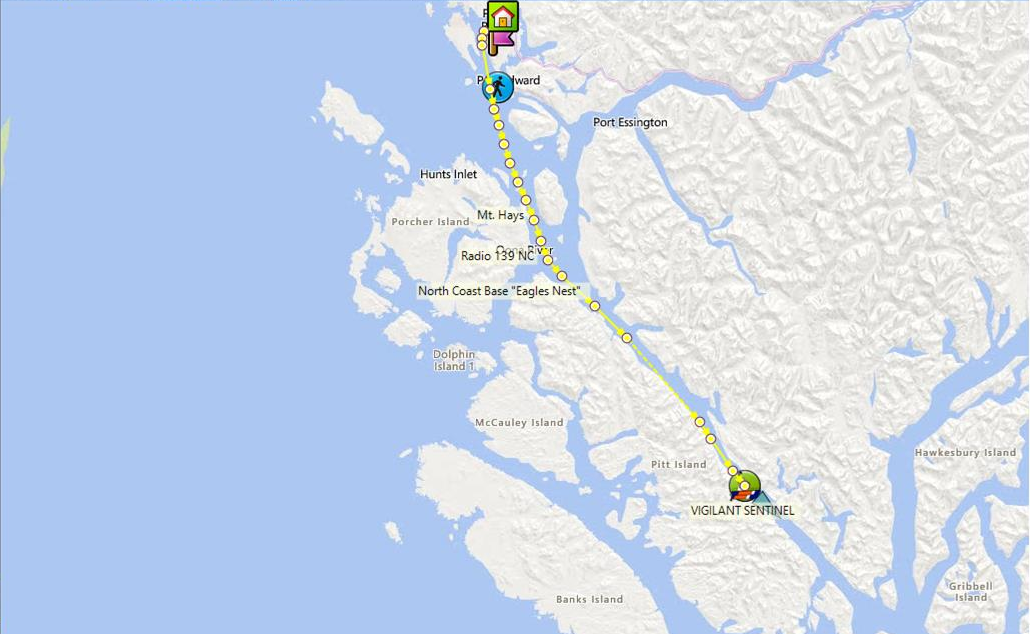Western Canada Marine Response Corporation’s (WCMRC) North Coast team now has dramatically improved radio communications thanks to an upgrading project jointly undertaken by WCMRC and the Canadian Coast Guard (CCG) at the CCG site on Gil Island. The project saw the replacement of WCMRC’s local analogue repeater with a new digital repeater, which can link to WCMRC’s Ultra-High Frequency (UHF) network.
Gil Island is located on the west side of Whale Channel in the south entrance to Douglas Channel, near Hartley Bay. The landscape between Hartley Bay and Kitimat is a long and rugged stretch of remote coastline with many inlets and channels. Having a digital repeater there means crews have radio communications from Prince Rupert all the way to Gil Island and the community of Hartley Bay.
“It greatly reduces the time WCMRC crews are out of communications between Hartley Bay and Kitimat,” said Randy Neufeldt, operations area manager, south coast, who managed the project on behalf of WCMRC. “For a vessel to go from Prince Rupert to Kitimat, they travel down the Grenville Channel, which is a long, narrow, and deep fjord, and up until now we have had no radio communications while in that area, so this is a significant improvement. It has increased our radio communications range from Prince Rupert by roughly 200 km.”
WCMRC’s teams use a variety of tools to communicate up and down the coast and on the water. This includes a radio communications network, which involves both UHF radios and Very High Frequency (VHF) radios, as well as satellite phones. UHF radio communications is a private frequency assigned to WCMRC—a company radio system—while VHF radio communications are public access. Until now, WCMRC has not had significant UHF coverage on the north coast.
The new digital repeater also enables a vessel travelling in the southern shipping lane to potentially speak by UHF radio to a vessel up north.
“Vessel-to-vessel communications through WCMRC’s radio system means we can have UHF radio communications from a vessel in Victoria to a vessel in the Grenville channel,” Randy said. “It also improves our base-to-vessel communications. Radio communications are better for transmitting communications back and forth when faced with an urgent situation. They are user-friendly and offer an immediate way of contacting crews when they are on-water.”
The new repeater was tested this past August from Prince Rupert to Hartley Bay, a 130km distance. The teams were able to chat back and forth on a strong radio signal from the vessel to the office.
WCMRC has three repeaters on the North Coast, one in Vancouver, one on Salt Spring Island, and one on Mt. Bahokus in Washington State at the northern tip of the Olympic Peninsula, which covers the southern shipping lane.
According to Randy, more improvements are on the way.
“We are looking at installing a repeater in Port Alberni along the Alberni Inlet, and potentially in Campbell River as well,” he said. “We also plan to upgrade an existing, decommissioned repeater in the Victoria area, on Mt. Helmcken.”
In transboundary waters, WCMRC is working closely with its counterparts in the U.S., Marine Spill Response Corporation (MSRC), to improve and develop transboundary radio communications systems.
“We want to ensure we can work off each other’s repeaters and support our respective communications systems,” explained Randy. “MSRC have a repeater in the Mt. Constitution area in the San Juan Islands and they are working to upgrade it to make sure it works for WCMRC, and we are going to do that for the Mt. Helmcken repeater as well. This ensures we can cover higher traffic and higher risk areas.”

